CC-SORVA ORV Club has compiled a list of guidelines and equipment to help improve the users trail riding experience.
We have divided the riding guidelines into various subgroups intended to help the rider, when they need it. Please feel free to comment on the list, we want to provide accurate and valid information for all ATV riders alike. Your experience is valuable.
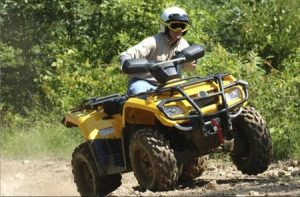
Confrontation
- Keep to the right
- Always yield to the ATV’s ascending a hill, vs the ones descending on a single trail.
- Smaller groups yield to larger groups riding on a single trail
- Slower group permits faster group to overtake on a single trail
- Use hand signals to indicate the number in party, last in party indicates last by raised fist
- When overtaking or passing another vehicle, do so in a slow controlled manner. This reduces the impact of air born debris, kicked up by the machine, on the overtaken vehicle
- Yield to larger vehicles
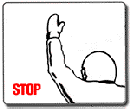
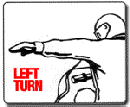
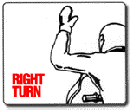
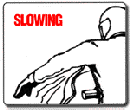
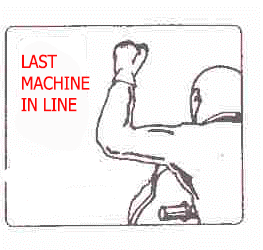
Group Riding
- Leader clearly informs rider of rules at a pre-ride meeting
- Leader asks members of the group, if anyone in party has any medical conditions
- Leader asks members of the group, if anyone has any safety certification
- Leader informs members of the group, where emergency personnel contact information is located
- Person riding is responsible for person back and front, if person in back is not visible, stop until they are
- Person is responsible to know number of riders behind them
- Do not pass other riders unless signaled to do so
- Change rider order only at area where entire group is all stopped and others can be aware of the new order, if a rider change is done outside of a full stop, communicate with leader and rear ATV the new order
- Indicate obstacles to following rider
- Pay particular attention to rider behind when overcoming obstacles
- Leader should slow party, until all have overcome the obstacle, validate group readiness with thumbs up, thumbs down sign before proceeding
- Stop until can see majority of party at stop signs, validate group readiness with thumbs up, thumbs down sign before proceeding
- Take stops regularly with large groups, stop frequency should be agreed at start of ride, if passing a long chain of obstacles, consider stopping to permit party to rest.
- Don’t over ride your capabilities, ride at your comfort
- Indicate stopping or slowing down
- Keep less experienced riders near the front, so they can instructed be and watched carefully
- Rear and lead riders should wear attire that is visible from a long distance, if terrain is suitable for an orange flag on a pole, then the rear machine shall sport one
- Riders must watch for signs of issues with ATV in front of them (eg. leaking fluid, stuck branch, wobbling wheel)
- Communicate with rider in front by flashing lights
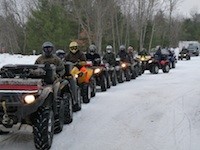
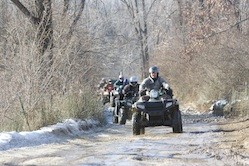
Land and Property
- Close all gates that you open (common in SD & Wyoming)
- Carry out what you carry in (don’t litter)
- Tread Lightly & Respect the land
- Don’t spin or do donuts. ATV donuts leave scars or ruts on dirt road, do not put riders in a positive light
- Seek permission before traveling, if land is private
- On Dirt roads, slow down near dwellings, don’t raise dust
- Put back, if you move things
- Be aware of surroundings
- Report property damage or garbage dumping to property owner, prove value back to owner to encourage continued riding privilege
- Assist Property owner in maintaining or repairing trail or property neighboring trail
- Beware of activities in area, if known lumber work in area, treat area with extreme caution, be attentive to sound and area ahead
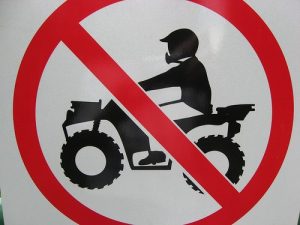
General
- Stay on the trail and observe posted signage
- Report downed trees or obstacles
- Offer assistance to others in distress
- Properly thank others for assistance or guidance
- Obey local laws
- Obey Signage posted by crews working in area (lumber/Mining)
- Don’t harass the wildlife
- Don’t do tricks outside of a designated area
- Be courteous to all, while riding or while stopped
- Don’t let emotions affect your riding style
- Learn your hand signals and use them, right, left hand bent up from elbow, hand open, fingers pointing up, Left hand pointing left hand open, stop, hand closed in a fist, arm pointing up (insert pics here)
- Wave at others
- Do not hesitate to ask questions, or advice from other riders, riders want to help
- Clear small obstacles and branches if they pose danger to others and pose no risk to you to remove them
- Noise is enjoyed in a special park, not so on the trail. Minimize noise, especially in areas near dwellings or businesses
- Stop when signaled by others or Enforcement officials
- Stop at wide areas of trail or designated areas, do not blaze a new spot
- When stopping, leave trail clear, so that others can pass
- Do not light fires outside of designated areas
- Do not throw cigarette butts into the woods, extinguish all flame before stowing or disposing properly
- When using outdoors as restroom, bury human fecal matter
- When burning a fire, do not dispose of plastics or glass within fire. It is ok to burn paper or cardboard within the fire.
- When riding at night, dim lights when approaching others, especially those that add HID lighting
- Be an ambassador for the hobby/activity
Safety
- Ride with lights on
- Leave at least two quad lengths space in front of you
- Leave greater distance in front of you if dusty or raining
- On difficult terrain, scout out area on foot before attempting on ATV
- On steep terrain, provide scout with tow rope before climbing
- On steep Terrain, lean uphill or stand uphill
- Keep appendages within the confines of the ATV rider area, the ATV weighs more than you
- Stand while riding over moguls, The legs will absorb part of the shock, permitting greater control of ATV, if uncertain on how to properly stand consult a more experienced rider
- Do not exceed passenger count specification of ATV
- Follow the age recommendations of the ATV class
- Do not let underage riders ride unaccompanied
- Do not operate under the influence of a controlled, prescribed, or illegal substance
- Know your ATV, sounds, feel, limits
- Ride wisely, use your head for more than a helmet rest.
- When fording unknown water, treat it as if there are hidden obstacles
- Do not attempt to cross water at high rates of speed
Parking, Trailhead & Quad
- Park at the trailhead in designated areas, smaller vehicles in smaller spots, large vehicles in larger spots
- Do not block Emergency Exits with vehicle
- Leave adequate but not excessive room between vehicles, if early park near as possible to markers, not in the middle
- Leave on front seat, name and number in party riding, show time of departure on paper leave a form of contact info, ensure paper is visible from side window (do not show estimated time of arrival)
- Leave room to exit and do not block others in.
- Park ATV’s in manner that does not obstruct regular vehicle travel
- When parking in vehicle spot at store or not at trailhead, minimize spots used by parking multiple ATV’s in spot
- When fueling ATV, Park ATV’s side by side while fueling at station, this obstructs the regular traffic flow less.
- If parking on an incline, block wheels of trailer
Apparel
- Wear head protection that is approved by DOT or Snell
- Recommend visor on helmet
- Wear Eye protection, suggest ventilated and filtered to reduce dust intake
- Wear footwear that provides shin or ankle protection
- Always wear a shirt, recommend long sleeved or riding jacket
- Recommend long pants able to withstand a degree of abrasion
- Recommend form fitting riding gloves, with a degree of padding. These style reduce hand/thumb fatigue
- Recommend body armor if riding in tight trails
- Recommend dust mask, if riding in dusty area
- Recommend neck support if riding fast rough trails or in scramble area
- Secure wallet in watertight area on ATV or put in Ziplock and secure in ATV.
Additional Accessories
- Ziplock first aid kit with a few bandages, neosporin, bugspray, suntan lotion, aspirin, chewing gum, superglue, a needle If room permits a formal first aid kit.
- A Knife, Recommend multifunction tool brand like Leatherman or Gerber
- Small pocket saw, if space permits
- Small air horn and Whistle, use for emergency and getting attention of people. Recommend radio, or two, if space permits
- Compass or GPS
- Handwipes
- Toilet Paper
- Small shovel/trowel
- MAP of area
- Small pocket saw for clearing small trees in an emergency
- Spare batteries for GPS, If space permits
- Flashlight
- Bungie Cords
- 20 feet of 1/4 inch rope
- Tow strap
- Spare spark plug and associated removal tool
- Drinking water
- If on medication place in ziplock bag with emergency first aid kit
- Non-salted peanuts or other non-salty snack that withstand temperature changes
- Remove valuables from pocket and stow in secure dry area
- Zip ties in various sizes
- Duct Tape
- Clean Rag
- Paper Towels
- Stow emergency money in waterproof area on ATV.
- Have emergency information about you, relatives, ATV, Tow vehicle, including pictures in emergency Ziplock bag, this is useful if you become separated from the ATV, or something happens to tow vehicle. If possible have info printed on business card stock, and have on ATV, you and Tow vehicle
- Stow Cell phone in ziplock bag and place in secure area on ATV
- Balance load on the ATV, Do not put heavy materials behind luggage rack, or excessive weight on one rack or another, improper weight distribution will severely inhibit your ability to control the ATV, with tipping or rolling over likelihood being increased
All the above accessories should be able to fit into a medium fanny pack than can either be bungied onto a sport quad or within a utility quads factory equipped storage areas.
Preparation
- Ensure all paperwork is with you, both for ATV, Tow vehicle, and trailer. (Registration, insurance, license, ORV sticker,)
- Check Oil
- Check Grease fittings
- Fuel
- Check Antifreeze
- Clean ATV of organic matter (try to avoid bring plant life from one region to another)
- Check tires (air pressure and tire condition for damage)
- Check Rims
- Check winch (if equipped)
- Check all body panels and fasteners
- Bring spare oil
- Bring Spare Gas
- Check lights and instrument panel, ensure all idiot lights light when you turn on ignition
- Put toolbox in trailhead vehicle to do simple service(for you or someone else)
- Check tie down straps, Never settle for just one, go with two or more
- If using ramps ensure when load and unloading they are tied down securely and the ramp doesn’t move.
- Check over tow vehicle similarly to ATV
- If using a trailer, check out trailer similar to above
- In Tow vehicle have a set of jumper cables or a booster battery pack.
- In tow vehicle/trailer ensure you have a full first aid kit
- In tow vehicle/trailer ensure you have a fire extinguisher, with the proper Class B (&C) rating.
- In Tow vehicle or Trailer have spare set of clothes/shoes and a towel(Don’t Panic)
- In Tow vehicle or trailer, have a second set of keys hidden in case you lose the ones with you.
- In tow vehicle or Trailer have drinking water
- In tow vehicle or Trailer have full formal first aid kit.
- In tow vehicle or trailer have spare tie down straps
- In Tow vehicle or trailer have a 5lb hammer
- In Tow vehicle or trailer have a jack and appropriate tools to change a tire on the ATV, truck, or trailer
- In Tow vehicle or Trailer, have a list of local emergency contacts and directions to them (hospital/Sheriff/DNR/ETC)
- In tow vehicle have spare set of information about ATV, VIN, CC’s model, year, mileage as well of a picture of the aTV. This information is useful if vehicle is stolen or damaged beyond repair.
- AS mentioned in another section have contact information for family in vehicle, but have detailed list in glove box
- If you require medication, leave emergency supply in vehicle. Also state on contact list your condition and what to do it problem occurs.
- Leader of group ride. Gather special medical needs information form all riders prior to ride. Suggest information be kept sealed unless needed. Summarize individuals require special treatment and leave copy in vehicle, keep primary copy with you should it be needed on ride.
Follow-up
- Check over ATV following ride
- Remove major debris and sticks at site
- Look for areas of impact or damage while removing debris
- If possible do light cleaning with water at site, no soap or detergent.
- Load vehicle and tie down securely
- Ensure ATV is in park or with brake on
- Ensure ATV is off
- Visually inspect tow vehicle and trailer before departing
- Ensure trailer is secure to tow vehicle
- Check lights.
- Write down any major issues or obstacles found on trail
- Ensure area around vehicle is clear of litter
- Pickup after others as well as self.
- Write down positive aspect of trail
- Report via web or mail your experience with the trail
- Notify those responsible for maintenance of any issues as well as your experience.
